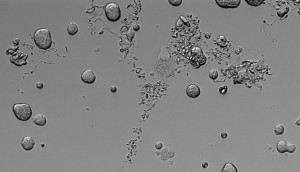
To manufacture platelets in the laboratory, we need to find the switch that starts their production.
The problem is that Italiano really couldn’t; he needs every platelet his lab can put its hands on. A platelet biologist in Boston Children’s Hospital’s Vascular Biology Program, Italiano is trying to find ways to manufacture platelets at a clinically useful scale.
To do that, he needs to develop a deep understanding of the science of how the body produces platelets, something that no one has at the moment.
The path by which blood stem cells develop into megakaryocytes—the bone marrow cells that produce and release platelets into the bloodstream—is already known, Italiano says. We also know that platelets are essentially fragments of megakaryocytes that break off in response to some signal.
But that’s where our knowledge of platelet production largely ends. “Megakaryocytes themselves are something of a black box,” Italiano explains. “If you microinject the cytoplasm of an active megakaryocyte into a resting megakaryocyte, it will start to produce platelets as well. But we don’t know what factor or factors cause them to start platelet production.”
As Italiano and his laboratory peer into that black box, they know the stakes are big. Because in the end, they want to greatly reduce doctors’ and patients’ dependence on donated platelets.
Making more platelets, faster
Platelets play a critical role in wound healing, and emerging evidence shows that they also influence angiogenesis and cancer metastasis. Cancer patients often receive transfusions of platelets, and they are a mainstay of operating rooms, emergency rooms and trauma centers everywhere.
In the U.S., nearly 2.2 million units of platelets were transfused in 2011, the most recent year with data available. This widespread use—and the fact that banked platelets are only good for about five days—has put platelets in short supply. Platelets have become big business: a single unit (which can contain between 70 and 600 billion platelets, depending on how it’s collected) costs an average of $536.
Italiano notes that it is possible to make megakaryocytes and platelets from hematopoietic (blood-forming) stem cells (HSCs) using a compound called thrombopoietin, but it’s not a quick or efficient process. “Thrombopoietin takes five to 10 days to make megakaryocytes from HSCs,” he says. “And in vitro, only about 10 percent of megakaryocytes will produce platelets.”
Italiano and his colleague Jonathan Thon, PhD, are already working on one way of boosting platelet production in the lab: with a microfluidic bioreactor that mimics the physical characteristics of megakaryocytes’ bone marrow environment.
Unlike traditional static culture methods for growing megakaryocytes, the bioreactor is built to be structurally similar to bone marrow and exposes the cells to the same shear forces they experience within the real bone marrow environment. It also can act as a platform for studying physical and biochemical influences on platelet production.
Finding the ‘on’ switch

Megakaryocytes (rounded shapes) and platelet precursors called proplatelets (squiggly shapes). (Courtesy Joseph Italiano and Kellie Machlus)
To do that, Machlus is looking at megakaryocyte biology from every possible angle: proteomic, structural, genomic, you name it.
Machlus is essentially starting from ground zero. For instance, she wants to screen FDA-approved drugs for agents that trigger megakaryocyte maturation, but no one even knows what cellular markers to look for.
“This is uncharted territory, and megakaryocytes are really hard to work with,” Machlus says. “But we’re trying to take a systematic approach.”
They’re also hard to come by. Machlus and Italiano need lots of megakaryocytes for their experiments, but the cells are both hard to harvest and fairly rare; they make up less than 0.1 percent of cells in the bone marrow. For the moment, the lab is getting around this by using mouse megakaryocytes, as well as megakaryocytes created from human-derived induced pluripotent stem cells.
As Italiano cautions, their work is still in its very early days. But even with all the technical obstacles, the team is keeping its eyes firmly locked on the prize.
“If we can find something that triggers megakaryocytes directly to produce platelets, it would benefit millions of people,” Machlus says.







